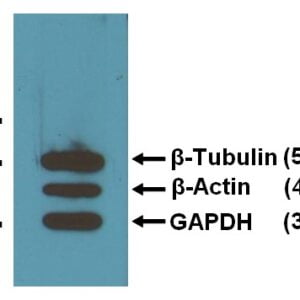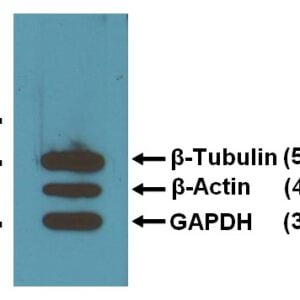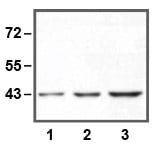| Weight | 1 lbs |
|---|---|
| Dimensions | 9 × 5 × 2 in |
| host | mouse |
| isotype | IgG1 |
| clonality | monoclonal |
| concentration | 1 mg/mL |
| applications | WB |
| reactivity | human |
| available sizes | 1 mg, 100 µg, 25 µg |
mouse anti-ERK1/2 monoclonal antibody (E31R) 1916
Price range: $100.00 through $2,600.00
Antibody summary
- Mouse monoclonal to ERK1/2
- Suitable for: WB
- Reacts with: human
- Isotype: IgG1
- 100 µg, 25 µg, 1 mg
mouse anti-ERK1/2 monoclonal antibody (E31R) 1916
| antibody |
|---|
| Database link: human ERK1 P27361 human ERK2 P28482 |
| Tested applications WB |
| Recommended dilutions WB: 1:1000 |
| Immunogen Full length recombinant human ERK1 protein |
| Size and concentration 25, 100, 1000µg and 1 mg/mL |
| Form liquid |
| Storage Instructions -20°C for 2 years or more. °Centrifuge after first thaw to maximize product recovery. Aliquot to avoid repeated freeze-thaw cycles. Store aliquots at 4°C for several days to weeks. |
| Storage buffer PBS, pH 7.2, 0.05% NaN3 |
| Purity affinity purified |
| Clonality monoclonal |
| Isotype IgG1 |
| Compatible secondaries goat anti-mouse IgG, H&L chain specific, peroxidase conjugated polyclonal antibody 5486 goat anti-mouse IgG, H&L chain specific, biotin conjugated, Conjugate polyclonal antibody 2685 goat anti-mouse IgG, H&L chain specific, FITC conjugated polyclonal antibody 7854 goat anti-mouse IgG, H&L chain specific, peroxidase conjugated polyclonal antibody, crossabsorbed 1706 goat anti-mouse IgG, H&L chain specific, biotin conjugated polyclonal antibody, crossabsorbed 1716 goat anti-mouse IgG, H&L chain specific, FITC conjugated polyclonal antibody, crossabsorbed 1721 |
| Isotype control Mouse monocolonal IgG1 - Isotype Control |
| target relevance |
|---|
| ERK1 (Extracellular signal-Regulated Kinase 1) and ERK2 (Extracellular signal-Regulated Kinase 2) are highly conserved members of the mitogen-activated protein kinase (MAPK) family, both playing crucial roles in cellular signaling pathways. They are serine/threonine kinases that become activated in response to a variety of extracellular stimuli, including growth factors, hormones, and stress. Upon activation, ERK1 and ERK2 translocate to the nucleus, where they phosphorylate numerous downstream targets, including transcription factors and other kinases. Through these phosphorylation events, ERK1 and ERK2 regulate a wide range of cellular processes, such as cell proliferation, differentiation, survival, and apoptosis. While they share significant similarities, ERK1 and ERK2 also display distinct functions and differential regulation in certain cellular contexts. Dysregulation of ERK1 and ERK2 signaling has been implicated in various diseases, including cancer, neurodegenerative disorders, and inflammatory conditions. This antibody can be used as a loading control when evaluating post-translational modification of ERK1/ERK2 and other cell singalling kinases and their modifications. Click for more on: loading controls and ERK1/2 |
| Protein names Mitogen-activated protein kinase 3 (MAP kinase 3) (MAPK 3) (EC 2.7.11.24) (ERT2) (Extracellular signal-regulated kinase 1) (ERK-1) (Insulin-stimulated MAP2 kinase) (MAP kinase isoform p44) (p44-MAPK) (Microtubule-associated protein 2 kinase) (p44-ERK1) |
| Gene names MAPK3,MAPK3 ERK1 PRKM3 |
| Protein family Protein kinase superfamily, CMGC Ser/Thr protein kinase family, MAP kinase subfamily |
| Mass 43136Da |
| Function FUNCTION: Serine/threonine kinase which acts as an essential component of the MAP kinase signal transduction pathway (PubMed:34497368). MAPK1/ERK2 and MAPK3/ERK1 are the 2 MAPKs which play an important role in the MAPK/ERK cascade. They participate also in a signaling cascade initiated by activated KIT and KITLG/SCF. Depending on the cellular context, the MAPK/ERK cascade mediates diverse biological functions such as cell growth, adhesion, survival and differentiation through the regulation of transcription, translation, cytoskeletal rearrangements. The MAPK/ERK cascade also plays a role in initiation and regulation of meiosis, mitosis, and postmitotic functions in differentiated cells by phosphorylating a number of transcription factors. About 160 substrates have already been discovered for ERKs. Many of these substrates are localized in the nucleus, and seem to participate in the regulation of transcription upon stimulation. However, other substrates are found in the cytosol as well as in other cellular organelles, and those are responsible for processes such as translation, mitosis and apoptosis. Moreover, the MAPK/ERK cascade is also involved in the regulation of the endosomal dynamics, including lysosome processing and endosome cycling through the perinuclear recycling compartment (PNRC); as well as in the fragmentation of the Golgi apparatus during mitosis. The substrates include transcription factors (such as ATF2, BCL6, ELK1, ERF, FOS, HSF4 or SPZ1), cytoskeletal elements (such as CANX, CTTN, GJA1, MAP2, MAPT, PXN, SORBS3 or STMN1), regulators of apoptosis (such as BAD, BTG2, CASP9, DAPK1, IER3, MCL1 or PPARG), regulators of translation (such as EIF4EBP1) and a variety of other signaling-related molecules (like ARHGEF2, DEPTOR, FRS2 or GRB10) (PubMed:35216969). Protein kinases (such as RAF1, RPS6KA1/RSK1, RPS6KA3/RSK2, RPS6KA2/RSK3, RPS6KA6/RSK4, SYK, MKNK1/MNK1, MKNK2/MNK2, RPS6KA5/MSK1, RPS6KA4/MSK2, MAPKAPK3 or MAPKAPK5) and phosphatases (such as DUSP1, DUSP4, DUSP6 or DUSP16) are other substrates which enable the propagation the MAPK/ERK signal to additional cytosolic and nuclear targets, thereby extending the specificity of the cascade. {ECO:0000269|PubMed:10393181, ECO:0000269|PubMed:10617468, ECO:0000269|PubMed:12110590, ECO:0000269|PubMed:12356731, ECO:0000269|PubMed:12974390, ECO:0000269|PubMed:15788397, ECO:0000269|PubMed:15952796, ECO:0000269|PubMed:16581800, ECO:0000269|PubMed:19265199, ECO:0000269|PubMed:34497368, ECO:0000269|PubMed:35216969, ECO:0000269|PubMed:8325880, ECO:0000269|PubMed:9155018, ECO:0000269|PubMed:9480836}. |
| Catalytic activity CATALYTIC ACTIVITY: Reaction=L-seryl-[protein] + ATP = O-phospho-L-seryl-[protein] + ADP + H(+); Xref=Rhea:RHEA:17989, Rhea:RHEA-COMP:9863, Rhea:RHEA-COMP:11604, ChEBI:CHEBI:15378, ChEBI:CHEBI:29999, ChEBI:CHEBI:30616, ChEBI:CHEBI:83421, ChEBI:CHEBI:456216; EC=2.7.11.24; Evidence={ECO:0000269|PubMed:35216969}; CATALYTIC ACTIVITY: Reaction=L-threonyl-[protein] + ATP = O-phospho-L-threonyl-[protein] + ADP + H(+); Xref=Rhea:RHEA:46608, Rhea:RHEA-COMP:11060, Rhea:RHEA-COMP:11605, ChEBI:CHEBI:15378, ChEBI:CHEBI:30013, ChEBI:CHEBI:30616, ChEBI:CHEBI:61977, ChEBI:CHEBI:456216; EC=2.7.11.24; |
| Subellular location SUBCELLULAR LOCATION: Cytoplasm {ECO:0000250|UniProtKB:P21708}. Nucleus. Membrane, caveola {ECO:0000250|UniProtKB:P21708}. Cell junction, focal adhesion {ECO:0000250|UniProtKB:Q63844}. Note=Autophosphorylation at Thr-207 promotes nuclear localization (PubMed:19060905). PEA15-binding redirects the biological outcome of MAPK3 kinase-signaling by sequestering MAPK3 into the cytoplasm (By similarity). {ECO:0000250|UniProtKB:Q63844, ECO:0000269|PubMed:19060905}. |
| Structure SUBUNIT: Binds both upstream activators and downstream substrates in multimolecular complexes. Found in a complex with at least BRAF, HRAS, MAP2K1/MEK1, MAPK3 and RGS14 (By similarity). Interacts with ADAM15, ARRB2, CANX, DAPK1 (via death domain), HSF4, IER3, MAP2K1/MEK1, MORG1, NISCH, and SGK1. Interacts with PEA15 and MKNK2 (By similarity). MKNK2 isoform 1 binding prevents from dephosphorylation and inactivation (By similarity). Interacts with TPR. Interacts with CDKN2AIP. Interacts with HSF1 (via D domain and preferentially with hyperphosphorylated form); this interaction occurs upon heat shock (PubMed:10747973). Interacts with CAVIN4 (By similarity). Interacts with GIT1; this interaction is necessary for MAPK3 localization to focal adhesions (By similarity). Interacts with ZNF263 (PubMed:32051553). Interacts with EBF4. {ECO:0000250|UniProtKB:P21708, ECO:0000250|UniProtKB:Q63844, ECO:0000269|PubMed:10393181, ECO:0000269|PubMed:10521408, ECO:0000269|PubMed:10747973, ECO:0000269|PubMed:11912194, ECO:0000269|PubMed:12356731, ECO:0000269|PubMed:15616583, ECO:0000269|PubMed:16581800, ECO:0000269|PubMed:18296648, ECO:0000269|PubMed:18435604, ECO:0000269|PubMed:18794356, ECO:0000269|PubMed:19060905, ECO:0000269|PubMed:19447520, ECO:0000269|PubMed:24825908, ECO:0000269|PubMed:32051553, ECO:0000269|PubMed:35939714}.; SUBUNIT: (Microbial infection) Binds to HIV-1 Nef through its SH3 domain. This interaction inhibits its tyrosine-kinase activity. {ECO:0000269|PubMed:8794306}. |
| Post-translational modification PTM: Phosphorylated upon KIT and FLT3 signaling (By similarity). Dually phosphorylated on Thr-202 and Tyr-204, which activates the enzyme. Ligand-activated ALK induces tyrosine phosphorylation. Dephosphorylated by PTPRJ at Tyr-204. {ECO:0000250, ECO:0000269|PubMed:17274988, ECO:0000269|PubMed:18983981, ECO:0000269|PubMed:19060905, ECO:0000269|PubMed:19265199, ECO:0000269|PubMed:19494114}.; PTM: Ubiquitinated by TRIM15 via 'Lys-63'-linked ubiquitination; leading to activation. Deubiquitinated by CYLD. {ECO:0000269|PubMed:34497368}. |
| Domain DOMAIN: The TXY motif contains the threonine and tyrosine residues whose phosphorylation activates the MAP kinases. {ECO:0000269|PubMed:10521408}. |
| Target Relevance information above includes information from UniProt accession: P27361 |
| The UniProt Consortium |
Publications
| pmid | title | authors | citation |
|---|---|---|---|
| We haven't added any publications to our database yet. | |||
Protocols
| relevant to this product |
|---|
| Western blot |
Documents
| # | SDS | Certificate | |
|---|---|---|---|
| Please enter your product and batch number here to retrieve product datasheet, SDS, and QC information. | |||
Only logged in customers who have purchased this product may leave a review.











Reviews
There are no reviews yet.